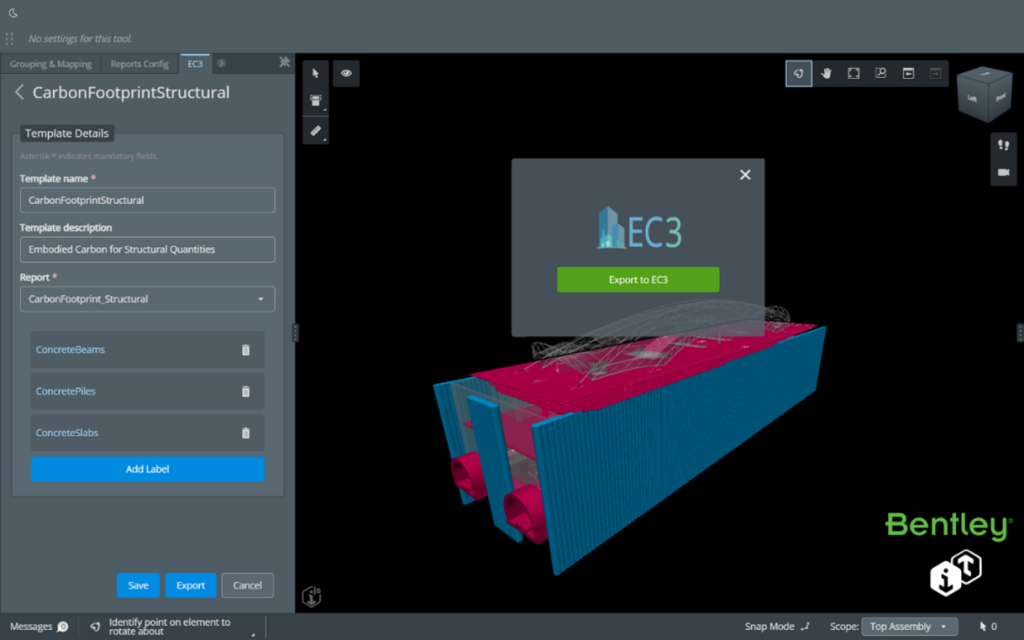Coming off of the COP27 conference earlier in November, serious conversations about reduction and mitigation are sure to continue. While technology can be seen as a possible solution to carbon reduction, these improvements will often require a closer look at the sources of carbon coming from industries like construction and industrial manufacturing. Currently, for the design and construction industry, the challenge is great; there is carbon utilized in all parts of creating the built world, from materials to running buildings throughout their lifecycles.
At COP27, Bentley Systems announced that they are planning to take a big step towards helping firms make better carbon decisions, through the integration of a carbon calculator into their iTwin platform. Bentley Systems is known for their infrastructure and engineering software and utilization of digital twins to improve processes, use and reduce rework and cost. Their iTwin platform will now enable carbon assessment, powered by the Embodied Carbon in Construction Calculator, EC3.
Originally developed by the nonprofit Building Transparency, EC3 is a free, open-access tool that allows for assessment and opportunities for the reduction of carbon, from supply chain and building materials. This “embodied carbon” is a major focus for carbon reduction efforts, because it can be addressed before a building project ever breaks ground. The calculator has also recently been integrated into Revit and Procore, but the Bentley iTwin connection will be the first that connects to a digital twin platform.

The EC3 integration allows Bentley’s infrastructure digital twin solutions, powered by iTwin, and third-party applications built on the Bentley iTwin platform, to simplify and accelerate the generation of carbon reporting and insights based on the no-cost, open-source EC3 carbon database and calculator. The Bentley iTwin platform is an open, scalable, platform-as-a-service offering that enables developers to create and bring to market solutions that solve real infrastructure problems by leveraging digital twins.
Rodrigo Fernandes, Bentley’s director of ES(D)G – empowering sustainable development goals, said, “This new integration in Bentley’s infrastructure digital twin platform exemplifies our strategy for empowering our users to achieve sustainable development goals. EC3 from Building Transparency is a perfect example of purpose-driven open, ecosystem collaboration, by which the private sector can come together to support and accelerate climate action.”
Kaustubh Page, director of product management, iTwin platform for Bentley Systems, said, “We see the EC3 integration as a critical feature for the Bentley iTwin platform, further driving us toward the sustainability vision for the platform. We are delighted to see our users taking advantage of our Carbon Calculation Service on the Bentley iTwin platform to achieve carbon workflows such as reporting, project optioneering, and optimizing material selection. We are glad to integrate an additional lifecycle assessment tool to unlock decarbonization workflows.”
Designers and sustainability engineers in the architectural, engineering, and construction industry spend a significant amount of time assessing or reporting on the environmental footprint of infrastructure projects, mainly when manually exporting and aggregating data from quantity counts and bills of materials. It can also be error-prone, requiring additional verification of successful ingestion by carbon tools. Moreover, AEC professionals do not want to be locked into one single carbon calculator as different calculators may provide different results (for instance, due to uncertainties in environmental product declarations), and carbon reporting and certification requirements differ as a function of the project, country, or infrastructure owner.
The added integration with EC3 not only creates time savings with improved accuracy but also provides uncertainty estimations of the EPD data and increases carbon transparency due to Building Transparency’s open-source/open-access strategy. Users can incorporate engineering data created by various design tools into a single view using the Bentley iTwin platform, generate a unified report of materials and quantities, and share it with different carbon analysis tools – now also with EC3 – via cloud synchronization.
One of the mutual users interested in this new integration is WSP, applying both the EC3 database and the Bentley iTwin platform on infrastructure projects such as the Interstate Bridge Replacement program.
“For WSP, carbon footprint analysis and reduction are imperative in planning, designing, building, and operating an infrastructure project from beginning to end,” said Thomas Coleman, vice president of WSP USA.
“Enabling better iTwin integration with EC3 is game-changing for us on multiple infrastructure projects. Implementing this link will significantly reduce the time and cost of generating EC3-based detailed embodied carbon analysis and reports along the design and construction stages. Ultimately, in the long run, we see this collaboration as one more step toward open, evergreen infrastructure digital twins, where carbon calculation and optimization are intrinsic and transparent in all infrastructure lifecycle stages across the entire value chain.”






